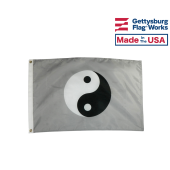Buddhist Flags
The Buddhist Flag
There are many different variations on the Buddhist flag for sale in different parts of the world. Most of them resemble the Buddhist flag that came into use near the end of the 19th century, but a few of the flags come from different traditions and bear almost no resemblance to the original flag. Very few of the variant flags are used outside of their country of origin, so the origin flag remains in use throughout the world as an international symbol of Buddhism that can represent every sect and school of the religion.
Colors and Symbolism of the Buddhist Flag
The international Buddhist flag consists of six vertical stripes. The first five stripes are blue, yellow, red, white, and orange. The final stripe contains all of those colors. The colors are the six colors that were said to emanate from the body of the Buddha when he attained enlightenment, and each of them represents practice or value in the Buddhist faith. The blue stripe represents peace and universal compassion, the yellow stripe stands for the Middle Path, the red stripe represents the blessings that arise from practicing the faith, the white stripe symbolizes the purity of Dharma, and the orange stripe represents wisdom. The final stripe represents the combination of all of those virtues into a single being.
Variant flags usually replace one of the stripes with a color that is significant to a specific branch of Buddhism. The symbolic value of the change can vary significantly from one school to the next, but the fact that many schools maintain the fundamental aspects of the flag's design represents the unity of Buddhism throughout the world.
History of the flag of Buddhism
The international flag of Buddhism was first designed in 1885 by the Colombo Committee of Sri Lanka. It was used locally later that year, but the flag did not spread to other countries immediately. The flag's shape was changed to make it more consistent with national flags in 1889, at which point it was presented to the emperor of Japan. It began to spread across the world shortly after that time. The process was slow, but the World Fellowship of Buddhists adopted the flag as the international symbol of their faith in 1952. The organization's approval made the flag significantly more popular and helped to spread it through the world, especially in nations where Buddhists were a religious minority. The flag has long since become a common sight in Buddhist communities, so it has become common to find the Buddhist flag for sale wherever the Buddhist faith can be found.



